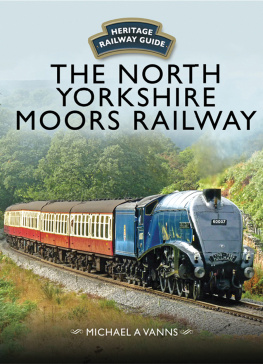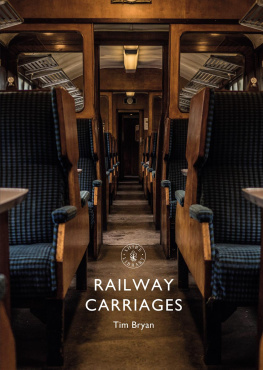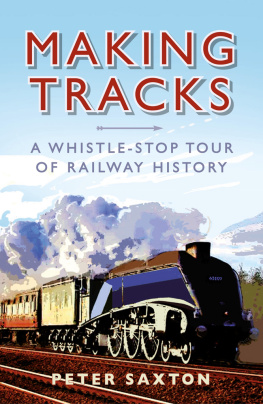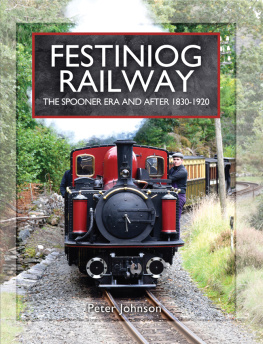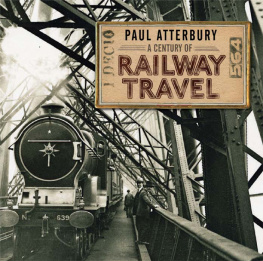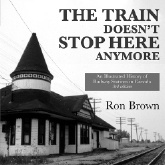
T HE N ORTH Y ORKSHIRE M OORS R AILWAY
THE NORTH YORKSHIRE MOORS RAILWAY
Michael A Vanns
First published in Great Britain in 2017 by
Pen & Sword Transport
An imprint of Pen & Sword Books Ltd
47 Church Street
Barnsley
South Yorkshire
S70 2AS
Copyright Michael A Vanns, 2017
ISBN 9781473892088
eISBN 9781473892101
Mobi ISBN 9781473892095
The right of Michael A Vanns to be identified as the author of this work has been asserted by him in accordance with the Copyright, Designs and Patents Act 1988. All rights reserved. No part of this publication may be reproduced or transmitted in any form or by any means, electronic or mechanical, including photocopy, recording or any information storage and retrieval system, without the prior written permission of the publisher, nor by way of trade or otherwise shall it be lent, re-sold, hired out or otherwise circulated without the publishers prior consent in any form of binding or cover other than that in which it is published and without a similar condition including this condition being imposed on the subsequent purchaser.
Pen & Sword Books Ltd incorporates the imprints of Pen & Sword Archaeology, Atlas, Aviation, Battleground, Discovery, Family History, History, Maritime, Military, Naval, Politics, Railways, Select, Social History, Transport, True Crime, and Claymore Press, Frontline Books, Leo Cooper, Praetorian Press, Remember When, Seaforth Publishing and Wharncliffe.
For a complete list of Pen and Sword titles please contact
Pen and Sword Books Limited
47 Church Street, Barnsley, South Yorkshire, S70 2AS, England
E-mail:
Website: www.pen-and-sword.co.uk
Preface
This book in the series Heritage Railway Guides has been written for all those who want to know something of the story behind one of Britains major heritage railways. It looks at the line through the North Yorkshire Moors taken over by enthusiasts, putting it into the broader history of the companies that originally built and subsequently ran it. As a guide, it cannot examine every aspect of the railways history, and for those who want to delve further, there is a selective bibliography. The last chapter covering the preservation years reflects the views of the author, which might not necessarily coincide with those of the people who have worked, or continue to work, for the organisations mentioned.
This book is dedicated to all those who have worked for and supported the North Yorkshire Moors Railway and kept the trains running.

Polished to perfection , North Eastern Railway Class A 2-4-2 No. 674 standing on the turntable at Whitby in the first years of the twentieth century. Sixty of this type of locomotive were built to the designs of the companys Locomotive Superintendent, T.W. Worsdell, who was in office between 1885 and 1890. (Real Photos)
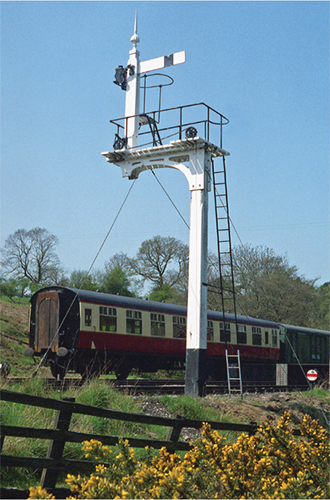
The up starting signal at Goathland station, a fine example made for the North Eastern Railway (NER) by McKenzie & Holland of Worcester. It was recovered by the North Yorkshire Moors Railway (NYMR) from Barlby Crossing, Selby and erected at Goathland in 1972 and then repositioned to the location illustrated here in 1987. (Author)
Introduction
O ne of the most interesting aspects of creating the three books in the Heritage Railway series was trying to account for the reasons why the railways have developed in the way they have after they were taken out of British Railways ownership. Obviously there have been many factors, ranging from the physical constraints of the route to the resources available to maintain and run trains. But perhaps the fundamentals of preservation and operation, and the way these two have been balanced out over the years, have influenced the appearance of heritage railways more than any management, staffing or financial issues. Because the initial aim of the Main Line Steam Trust was the preservation of a section of main line, it could be argued that the goal for the Great Central Railway in Leicestershire has been more towards the recreation of a main line with appropriate track layouts and signalling, compared to the original aim of the North York Moors Historical Railway Trust (NYMHRT), formed in 1972, that was To advance the education of the public in the history and development of railway locomotion by the maintenance in working order of the historic and scenic railway line between the towns of Grosmont and Pickering.
Although this statement has been considerably refined over the years, especially since the organisation became a registered museum requiring the words preservation and conservation to appear in the aims of the Trust, that initial emphasis on the running of trains does help explain why many original features on the North Yorkshire Moors Railway (NYMR) have been sacrificed since 1967 to provide better facilities for passengers and the maintenance of locomotives and carriages. It helps explain why so many metal-clad sheds have been erected and why track maintenance and renewal and signalling on the line have developed in the way they have. It is also important to record that the NYMR has been run as a heritage line for longer than it was in the hands of the LNER and British Railways combined, and those businesses also had to adapt to changing circumstances. But perhaps more importantly, with the exception of the original Whitby & Pickering Railway Company, no organisation before the NYMR had to operate the line as a self-contained unit. Locomotive and carriage maintenance did not have to be carried out and stock stored permanently somewhere between Pickering and Grosmont. Civil engineering and permanent way equipment and heavy lifting gear did not have to be accommodated either, all that being brought in from elsewhere when needed. In many ways, since 1967 the NYMR has had to become a self-contained LNER. All those issues and many more have combined to make the NYMR what it is today and it makes a fascinating story.

Repatriated from Greece in 1984, restored and named Dame Vera Lynn , War Department 2-10-0 is on the 1 in 49 climb between Grosmont and Goathland during the summer of 1989. (Authors collection)
Early Days to Best Years
W hen the Whitby & Pickering Railway (W&PR) was completed in 1836, it was already old-fashioned. Since 1830 the Liverpool & Manchester Railway (L&MR) had been running trains on a double train main line, demonstrating emphatically that the future was steam powered, and within a few years (1838), an even more ambitious railway the London & Birmingham Railway (L&BR) would be completed, one that in the twenty-first century still remains the spine of Britains railway network.
When it opened, horses pulled single coaches on the single track W&PR at almost the same speeds as stage coaches on the countrys network of turnpike roads, whereas on the L&MR and L&BR, coaches were coupled together to form trains capable of transporting many more people than a single stage coach and they were pulled by modern steam locomotives that travelled at three or four times the speed of horses.

